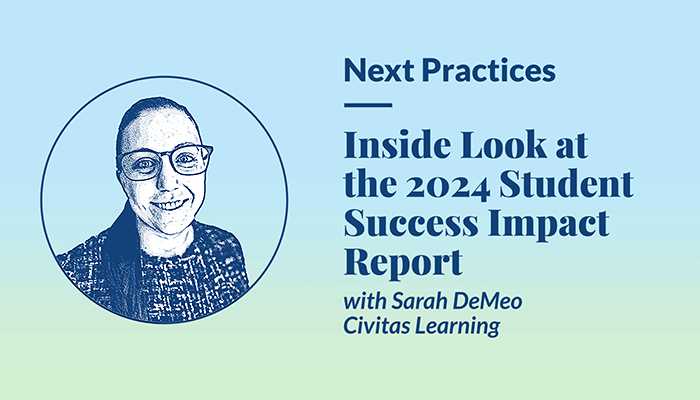
Inside Look at the 2024 Student Success Impact Report with Sarah DeMeo
Share this Post
Subscribe: Spotify | Apple Podcasts | Youtube Music | Full Transcript
Each year, we conduct a meta-analysis of Initiative Analyses run by our partner institutions to determine the impact of their success initiatives on persistence. As part of this effort, Civitas Learning produces an annual Student Success Impact Report that reflects directional trends across our partner institutions. Our team looks at hundreds of initiatives to provide actionable insights on how institutions can improve their specific student success programs.
Listen to our conversation with Civitas Learning Data Analyst Sarah DeMeo for more details on the report’s contents and what leaders should know.
Extracting Trends from Student Success Initiatives
To generate the report results, our team categorizes each initiative assess by our partner institutions and evaluates how it impacts persistence across different student groups. Powered by the Civitas Learning Initiative Analysis platform, we’re able to measure the impact of specific initiatives, programs, and policies on persistence and apply those findings to broader trends.
Initiative Analysis looks at two data pieces when comparing students:
1. Propensity score: The likelihood of a student to engage in an initiative
2. Persistence score: The likelihood of a student to persist into the next term
It then compares these scores between students who participated in the initiative and those who did not (but who were still eligible). We can then see the impact of a persistence lift holistically across the entire student population, as well as in specific student groups across categories like course modality, race, ethnicity, gender and more.
Initiative Analysis in Action
The Initiative Analysis tool is designed to evaluate the impact on persistence of each institution’s unique initiatives. While practical applications will vary from school to school, a recent example from the University of Texas at San Antonio (UTSA) applies to many institutions. In a conversation with Dr. Tammy Wyatt and Steve Wilkerson, we learn how their team used Initiative Analysis to uncover important insights into their academic coaching program.
Initiative Analysis revealed that UTSA’s academic coaching program generated a minimal persistence lift among honors students (the majority of program participants) but a notably higher lift among at-risk students. Guided by this insight, they redirected their marketing tactics to target this student population and noticed significant academic improvement within that group as a result.
UTSA is one of many schools grappling with growing student needs. Institutions with ongoing student success programs can use Initiative Analysis not only to see which programs are working for students broadly, but also to uncover which student groups will benefit most, so they can allocate their resources to support those who will benefit most.
What’s in the report
This year, we looked at hundreds of initiatives taking place at our partner institutions to uncover the most important trends in student success. Extrapolating on last year’s data, we were able to include longer longitudinal data that covers broader trends. Here are a few of the initiatives that have stood the test of time and that rose to the top this year. These are the tip of the iceberg, so readers interested in more of this year’s trends can download the full report.
Student-led academic planning
We know that students who engage with their academic planning and become thought partners in the process have higher persistence rates. This is an extension from last year’s data which found substantial academic benefits surrounding academic advising.
Co-curricular engagement
Academic advancement continues to be a top priority for institutions, but many are expanding their initiatives to include more holistic student engagement tactics. Leaders are starting to think about how students are engaging in organizations, recreation, Greek life, and other extracurricular activities that contribute to a constructive student experience.
Career development
As more students view higher education as a stepping stone to a career, institutions are directing more resources to preparing students for a successful life post-graduation. The goal is to help students not only be successful at attaining their degree, but also to prepare them for a career and provide a positive alumni experience.
How Institutions Can Apply Insights from the Report
Aside from staying informed on this year’s higher education trends, institutional leaders can use this report to inspire their own student success initiatives. By looking at persistent trends, leaders can ask questions about which programs are working and which initiatives need to be adjusted. And with the help of Initiative Analysis, they can start generating their own data to pinpoint how initiatives work on their campus and in their specific student groups. These insights open new opportunities to become thought partners in student success at your institution and combine creativity with data to develop effective strategies.
To learn more about how institutions can use this report, listen to the full conversation on Next Practices.
Links and Resources:
- Download Your Copy of the 2024 Student Success Impact Report
- Watch On-Demand: Insights to Action: An Inside Look at the 2024 Student Success Impact Report
- Partnering with Institutional Research to Improve Student Outcomes with Dr. Steve Wilkerson and Dr. Tammy Wyatt
- 2023 Student Success Impact Report
- Civitas Learning Student Impact Platform
- Listen on Apple Podcasts | Spotify | Google Podcasts
